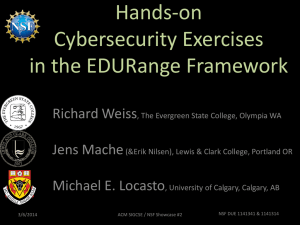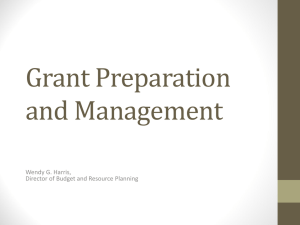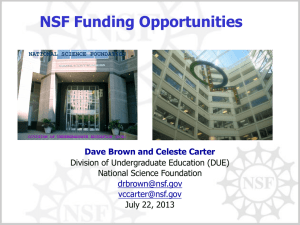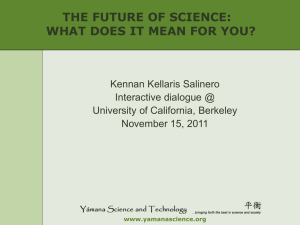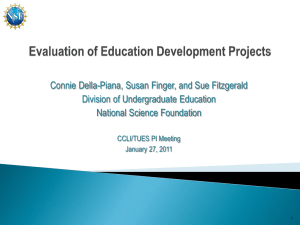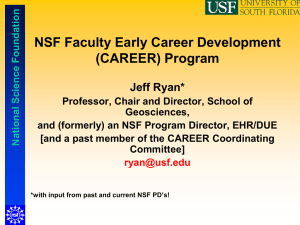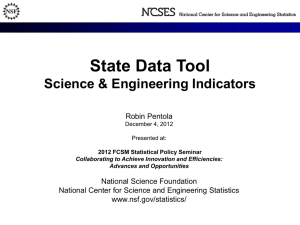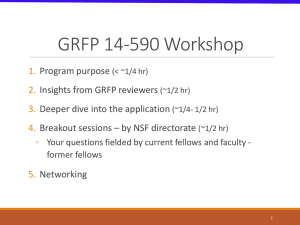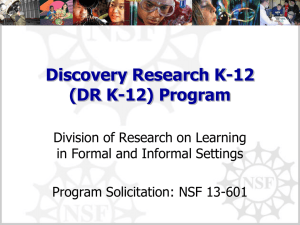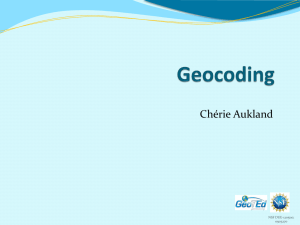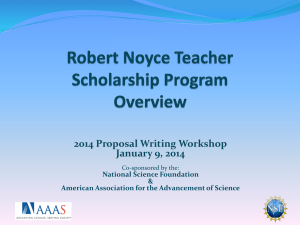2014-10-19_ASTC2014_NSF_Funding
advertisement
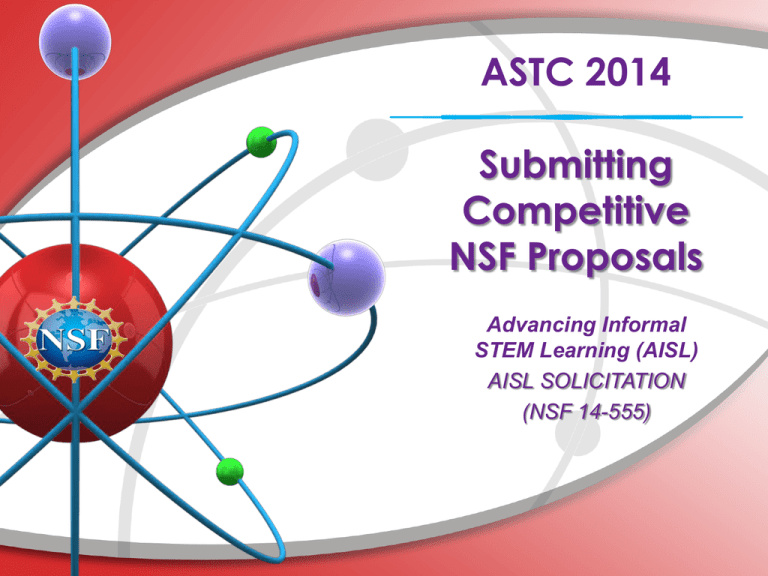
ASTC 2014 Submitting Competitive NSF Proposals Advancing Informal STEM Learning (AISL) AISL SOLICITATION (NSF 14-555) SESSION AGENDA Overview of EHR/NSF - Bob AISL Program Overview & Solicitation - Bob Project Types - Al Preparing Competitive Proposals - Wyn Review Process & Merit Review Criteria - Al Other NSF Programs & Resources Program Contact Information - Bob Questions 2 EHR Vision • A healthy and vital national science, technology, engineering, and mathematics (STEM) education enterprise. EHR Mission • To support research and development on STEM education and learning and to engage and grow a diverse, STEM-literate citizenry ready to advance the frontiers of science and innovate for society. Focus Areas • Learning and Learning Environments • Broadening Participation • Workforce Development 3 Research, Development, and Model-Building for STEM Learning Investments where questions inform development and model-building and, in turn, model building and development give rise to new questions. Research Development & ModelBuilding 4 Common Guidelines for Education Research and Development 5 Rationale for AISL Projects • • • • 6 Connecting individuals with the building blocks they need to understand cutting-edge science and their world Building theoretical and empirical foundations for effective learning in informal environments Furthering the assessment of such learning Supporting the use of innovative methods to address questions of importance to those who work in informal STEM learning settings EHR Funding Rates for FY 2014 7 AISL Program Overview & Solicitation AISL Program Advancing – Innovative projects that advance the field through building knowledge via innovative approaches and research. Informal – Out-of-School learning that makes learning lifelong, life wide, & life deep. STEM – Not just focused on science, but all of NSFfunded STEM. Learning – Learning outcomes include: interest, engagement, motivation, behavior, identity, persistence, understanding, awareness, knowledge, and use of STEM content and practices, and 21st century skills. 9 AISL SOLICITATION (#14-555) IMPORTANT DATES Proposal deadlines: November 14, 2014 (FY 2015) New READ 10 solicitation in 2015 THE SOLICITATION MULTIPLE TIMES!!! Project Types Pathways Exploratory development work or feasibility studies Should lead to field-advancing proposals of other project types Should produce evidence, findings and/or deliverables that form basis for further work Should state how project informs future work & advances field Funding 12 up to $300,000 (duration up to 2 years) Research in Service to Practice Advances knowledge & provides evidence base for practice Primary focus on research questions Qualitative or quantitative data (evidence) and involve range of techniques Can also be syntheses or meta-analyses Includes literature review & detailed research plan Researchers Funding 13 and practitioners are close collaborators from $300K to $2 million for 2-5 years Innovations in Development Builds knowledge through the development of innovative products Builds on evidence from prior practice & research Describes an explicit theory & logic model/theory of action Includes plan & process for design, development & implementation Includes plan for knowledge building through research and/or evaluation Funding: 14 $500K to $3 million for 2-5 years Broad Implementation Expands models, programs, technologies, assessment or other advances that have documented record of success Expands reach: age, gender, geography, etc. Includes plan & process for design, development, & implementation Builds knowledge through research and/or evaluation Funding 15 $500K to $3 million for 2-5 years •SCIENCE LEARNING+ • An international partnership • • • 16 Established by NSF, UK-based Wellcome Trust, and UK Economic and Social Research Council In collaboration with the MacArthur Foundation, the Gordon and Betty More Foundation, and the Noyce Foundation Science Learning+ funding (up to $14.4mil) will support research in out-of-school learning • Research into how learning happens outside the classroom • Exploration of effective practice • Building the evidence base •SCIENCE LEARNNG+ (2) • • 17 Objectives • Strengthen the research and knowledge base • Bridge the practice – research gap: • Share knowledge and experience: Funding priorities • Understanding learning • Engagement in STEM • Skills development • Equity, diversity, and access to informal learning settings • Measurement of outcomes Conferences, Symposia & Workshops Relate to AISL program goals Focus on development of communities of practice, field-advancing practice, assessments, & research agendas Proposals request >$50,000, due on deadline Proposals up to $50,000 may be submitted at any time 18 Preparing & Submitting Competitive Proposals Grant Proposal Guide http://www.nsf.gov/publi cations/pub_summ.jsp?o ds_key=gpg 2014 AISL Funding $37.9 million funding for new awards: • 13 Pathways • 5 Research in Service to Practice • 11 Innovations in Development • 5 Broad Implementation • 7 Other: RAPID, EAGER, conference, co-funds 20 Preparing to Submit a Proposal www.fastlane.nsf.gov; 6188 (7 1-800-673- AM to 9 PM Eastern Time • M-F) Submit early Required sections IRB Check your proposal for compliance—just hit the button in Fastlane 21 Project Summary First Sentence Type of Proposal: Pathways, etc. Overview Describe type of activity that will result, objectives & methods Intellectual Merit and Broader Impacts Must include separate statements on each of these two NSB criteria 22 Project Description (Narrative) Identify project type in first sentence Cover the following in the project description: Project Rationale Project Design Dissemination Plan Evaluation & External Review Management Plan 23 Project Rationale Describe primary goals, hypotheses, models, products or research questions Explain how the project builds on prior research and practice Explain how the project is innovative and builds knowledge for the field Describe STEM content Discuss results of prior NSF support and how (where relevant) it informs the design of the proposed project 24 Project Design Describe project deliverables Describe measure of learning outcomes for target audiences and how they were selected Identify public and/or professional target audiences & how they will be reached Describe (if relevant) how the project will broaden participation for underrepresented groups Describe how the project will generate knowledge, including questions, methods, instruments & analysis Describe project impact on informal STEM 25 Dissemination Plan Describe the key elements of a creative communications plan to disseminate project products and/or findings to the general public, researchers, policy makers, and practitioners Required to share design, findings, and products with the CAISE: informalscience.org website. 26 Evaluation & External Review Evaluation & External Review processes are to: 1. Ensure that projects get appropriate, rigorous input throughout the life of the project so that the research and development components of the project are actively improved as a result. 2. Ensure there is accountability: The federal govt is funding you to enact as specific project—Did you end up doing what you said you would do? What was the quality of your work? 3. All projects must build knowledge—advance the field through research, evaluation, or a hybrid. There are as many permutations as there are proposals. Most critically, each PI team figure out what makes the most sense to meet their project’s goals and include a clear design and description of an evaluation and external review plan in their proposal. 27 Evaluation & External Review Examples: Research 1. 2. 3. studies: External critical review: Improve quality of research process Did project meet goals? Level of quality? The research results = knowledge building component. Development 1. 2. 3. 28 components: Evaluation: Iteratively improves design and implementation (internal or external evaluator) Did project meet goals? Level of quality? If evaluation is the knowledge building component, then summative evaluation needed. If research is the knowledge building component, see above. Management Plan Describe the project leadership team, other members of the project team & advisory board, and how their combination of expertise is appropriate Describe the management plan for how the team and partners will work collaboratively to achieve project goals Provide a workplan for key project tasks/deliverables 29 Supplementary Documents Brief letters of commitment or cooperation Summaries of formative & summative evaluation findings of prior work (2 page max.) Additional details of logic model, theory of action and evaluation plans (5 page total max.) Additional 30 pages (max.) of supporting info, such as media scripts, exhibit sketches, etc. Data Post 30 Management Plan Doc Mentoring Plan Budget Should be consistent with level of work – you do not have to request the maximum! Two months salary: No more than two months of salary for senior personnel on all NSF grants without a justification Indirect cost rates: Set by the institution and auditors and is non-negotiable. No cost sharing. 31 Avoid Ineligible Expenses Capital or operating expenses Major or office equipment Vehicles Undergraduate tuition Paid advertising Admission fees Publications deliverable and curricula as the primary 32 Review Process & Merit Review Criteria Proposal Review Process Proposals are reviewed in review panel discussions that include a range of external experts (e.g. educational researchers, content experts, educators, developers). Reviewers rates each proposal as Excellent, Very Good, Good, Fair or Poor PIs receive reviews (3-4), panel summaries, and comments from POs, which are advisory. Programs have meetings where most final recommendations are determined. Funding is often negotiated through questions and, sometimes, project & budget revisions. 34 Merit Review Criteria Intellectual Merit and Broader Impact 1. What is the potential for the proposed activity to: a. advance knowledge and understanding within its own field or across different fields (Intellectual Merit); and b. benefit society or advance desired societal outcomes (Broader Impacts)? 2. To what extent do the proposed activities suggest and explore creative, original, or potentially transformative concepts? 3. Is the plan for carrying out the proposed activities well-reasoned, wellorganized, and based on a sound rationale? Does the plan incorporate a mechanism to assess success? 4. How well qualified is the individual, team, or institution to conduct the proposed activities? 5. Are there adequate resources available to the PI (either at the home institution or through collaborations) to carry out the proposed activities? Common Guidelines for Educational Research and Development NSF 13-126 - Joint effort between NSF and the Institute for Education Sciences at the U.S. Department of Education http://www.nsf.gov/pubs/2013/nsf13126/nsf13126.pdf? WT.mc_id=USNSF_124 NSF 13-127 - Set of FAQs http://www.nsf.gov/pubs/2013/nsf13127/nsf13127.pdf Goals of the Common Guidelines Project Improve the quality and pace of findings from education research and development proposals Develop an education infrastructure that supports more rapid and efficient knowledge development Aid NSF and ED in making informed choices about where to invest scarce research and development dollars Provide clarity for the field (and within the two agencies) A good reference for framing research & eval. 37 CAISE: InformalScience.org InformalScience.org website: redesigned and now compiles a large number of previously independent websites. Resource for potential AISL PIs: http://informalscience.org/nsf-aisl (or just look for NSF AISL in the upper middle on the informalscience.org homepage). Midway down the NSF AISL page is Resources for Working with National Science Foundation Support, which includes many evaluation resources as does http://informalscience.org/evaluation/evaluation-resources There are other proposal related resources, including on the CAISE-website at http://informalscience.org/about/informalscience-education/resources. 38 NSF Resources for PIs What has AISL funded? http://www.nsf.gov/awardsearch/ Put in AISL to see the vast range of what has recently been funded or just click on the link from the AISL webpage: http://www.nsf.gov/funding/pgm_summ.jsp?pims_id=504793 Also try key words related to your proposal topic/area; there are many search options to explore NSF Grant Proposal Guide (GPG) is very helpful as are FAQs: http://www.nsf.gov/publications/pub_summ.jsp?ods_ke y=gpg 39 IRB and other information is also on this page. Final Suggestions Submit early Spell check; Check grammar & punctuation (professional editor?) Talk early with Program Officers (POs); email DRLAISL@nsf.gov Post Submission: Take follow-up questions from NSF seriously 40 Reviewing for NSF? Interested in Serving as A Reviewer: Experience Serve Contribute the Proposal Review Process as a Content/Field Expert To Funding Decisions & Field Advancement Additional questions or interest in in being a reviewer: DRLAISL@nsf.gov 41 41 OTHER PROGRAMS Other DRL Programs… EHR Core ITEST DRK-12 43 EHR Core Research Foundational research: • STEM Learning • Learning Environments • Workforce Dev. • Broadening Participation Core Research proposals: $1.5 million/up to 5 years • Capacity Building: $300K/up to 3 years • Deadlines: Feb. 3, 2015 • 44 ITEST: Innovative Technology Experiences for Students/Teachers • • R & D of innovative models for K-12 to engage in STEM & ICT Must include students & can include teachers • Resource Center: http://www2.edc. org/itestlrc/defaul t.asp Target date: • Nov. 6, 2014 • 45 DRK-12 • • • • Project framed around research question Innovative resources, models & tools Four strands: Assessment, Learning, Teaching & Implementation Research Can draw from practice in formal & informal learning • • • • Can focus on single discipline or be crossdisciplinary Three types of projects: Exploratory; Full Design & Development; Conferences & Workshops Resource Center: http://cadrek12.org/ nsf-dr-k-12 New Program Announcement in 2015. 46 More EHR Programs… PRIME CAREER ATE Cyberlearning STEM-C EHR Programs/Dates: http://www.nsf.gov/funding/pgm_list.js p?org=EHR 47
